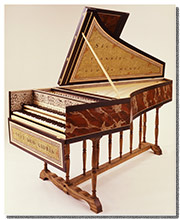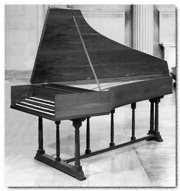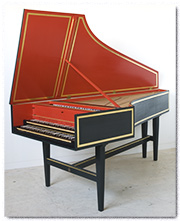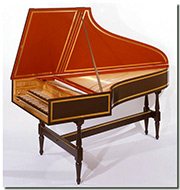|
| Flemish
Single-Manual Harpsichords of the 16th, 17th & 18th Centuries |
| We offer two Flemish single-manual
harpsichords. Each design is available in two versions –
either in the original range & disposition or a later, enlarged-range
version. The large instrument by Ioannes Moermans (GG/BB-f''')
is dated 1584. The small instrument by Andreas Ruckers (C/E-c''')
is dated 1640. By the 18th century, both instruments would have
become valuable but out-dated antiques - perfect for enlargement!
Both enlargements are carried out within the original case shape
and volume. Our Moermans à petit ravalement has the
range GG-e''' (transposing). The Ruckers has the range C-d'''
(transposing).
Detailed
Description
Available
as a kit (Moermans). |


|
| Flemish
Virginals of the 17th Century, 'Mother' and 'Child' |
| The large virginal (mother) is
disposed 1 x 8' with a range of 49 notes: C-c"'. The
small instrument (child), known as the ottavino, is disposed
1 x 4' and is pitched one octave higher than the mother. It stores
easily in the body of the larger instrument, hence the term from
the old Flamands, "Mother and Child." The
ottavino can be played either by itself or placed on
the mother and coupled to her creating a 1 x 8', 1 x 4' instrument.
The instruments can be also purchased separately. The ottavino
is an excellent kit for beginners.
Detailed
Description
Available
as a kit. |


|
| Flemish
Harpsichords à gran ravalement of the 18th Century |
We
offer two. Our 18th century double manual à grand ravalement
after Ruckers and Blanchet has the mid-18th century range of
nearly five octaves, FF-e''', 61 notes; transposing. The instrument
after Ruckers and Taskin adds the top f'''. They are disposed
with upper manual 1 x 8', lower manual 1 x 8', 1 x 4', buff
stop handstops and shove coupler.
These
harpsichords offer various possibilities for decoration. For
example, block printed papers for the interior of lid and case
with a plain or marbled exterior, or the plainer fashion of
a French 18th century harpsichord.
Detailed
Description |


|
| Flemish
18th Century Double Manual Harpsichord |
Our
18th century double manual harpsichord after J. D. Dulcken has
a range of five octaves, FF-f''', 61 notes; transposing. It
is disposed with upper manual 1 x 8' (dogleg), lute, lower manual
1 x 8', 1 x 4', buff stop handstops and shove coupler.
These
harpsichords also offer various possibilities for decoration.
They are particularly handsome in a simple wood finish or painted
in the plainer fashion of a French 18th century harpsichord.
This
is the real 18th century Flemish double!
Detailed
Description |


|
| French
Double-Manual Harpsichords of the 17th & 18th Centuries
|
| Our French double-manual harpsichords
(we offer six) have ranges of from four and one-half (GG/BB-d''',
Richard) to five octaves. Each is disposed with three ranks of
jacks and three choirs of strings, 2 x 8', 1 x 4', with a shove
coupler. Each
instrument is offered painted in a traditional French style,
with contrasting interior and exterior colors reconciled by
gilded mouldings and accented with gold leaf bands on case and
lid. We are delighted to work with customers in pursuit of more
'baroque' decorative schemes, as well.
Detailed
Description
Available
as a kit (Taskin). |


|
| English
Bentside Spinet of the 18th Century |
| The economy of space allowed by the
bentside spinet makes it an ideal instrument for musicians with
limited room. The five-octave compass (FF'f''', less FF#, 60 notes)
makes it a useful study and practice instrument appropriate to
virtually the entire harpsichord literature. Its sound, rich and
sonorous, is especially suited to chamber music and the music
of the English and Italian virginalists.
Detailed
Description
Available
as a kit. |


|
| German
Double-Manual Harpsichords of the 18th Century |
| We build two German 18th Century
double-manual harpsichords. The "small" double has a
range of 61 notes, five octaves, FF-f''', transposing. Its disposition
is: upper manual, 1 x 8'; lower manual 1 x 8', 1 x 4', buffstop.
The lower manual slides in to engage the upper manual dog-leg
jacks. It is available with Delrin or beechwood jacks. The "large"
double has the same range. It is disposed: upper manual 1 x 8',
lute; lower manual 1 x 16', 1 x 8', 1 x 4', buff stop, shove coupler.
It is available only with beechwood jacks.
Both instruments are offered in a simple decor - painted in two colors on a
matching trestle stand. The keywell surrounds are veneered, inlaid and crossbanded to
coordinate well with the ebony and bone key coverings.
Detailed
Description |


|
|